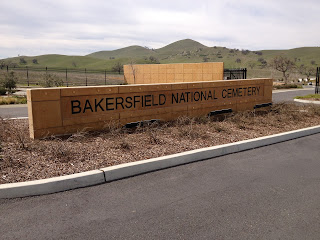Twas a beautiful morning in Bakersfield. The locals are hoping that it won't get any hotter or any cooler for the rest of the summer....
We jumped into the truck and drove east on Hwy 58 to check out the "Tehachapi Loop". This is a monumental engineering feat that allows the busy railroad tracks between Mojave and Bakersfield to gain (or lose) a significant amount of elevation in a short amount of space.
In the pic, Bakersfield is to the left and Tehachapi and Mojave to the right. The tracks come into the loop at the upper left, pass through a tunnel, loop around, and exit to the right. If you look closely, you can tell that the train cars are smaller at the far right and larger at the near right. The loop is .73 miles in circumference, and most trains, particularly if they are over 4000' long, will cross over themselves as this one is doing.
The loop was built by approximately 3000 Chinese recruited in China using picks and shovels and 600 barrels of black powder a week. It was built between 1874 and 1876, and remains one of the most viewed rail sections in the world.
We were fortunate to arrive at this viewpoint just as a train was entering the loop from the east. Within 20 minutes of its passing, another train followed in the same direction, and then a train that had been waiting on an eastbount siding came through in the opposite direction. By the time all the trains had completed their "loops", there were some 25 people standing along the side of the road in awe.
You can see a dirt road inside the loop on the left side. This goes to a farmhouse situated inside of the loop (out of sight in the pic). As per regulations, the engineer must blow his horn in a specified pattern whenever the train approaches and crosses a road, so that farmhouse must be a noisy! The railroad museum docent in Tehachapi noted that traffic varies, but there have been up to 50 trains counted in a 24 hour period. Wow! This is obviously the main thorough fare between the San Joaquin Valley and all points east.
Those points east (and west) are noted on the sign at the restored Tehachapi Depot. The depot is now a museum noting railroad history in the area, and also containing pics of the 1952 7.2 earthquake that destroyed most of the town and 3 of the 10 railroad tunnels near the loop. Repairs were made within 3 weeks and 2 days, and freight began to be transported again. The tracks in the mountains are so steep that over the years 17 people have died and millions of dollars worth of locomotives and railroad cars lost as brakes failed and equipment "ran away". There is an awesome display in the museum of a section of iron track that has a circular section removed by the drive wheels of a locomotive trying to gain traction as it tried to avoid roaring down the hill backwards. I couldn't get a pic, but the rail was literally melted from a height of 8 inches down to 1/2 inch in just 30 seconds! No indication whether the engineer saved the train. Let's hope so.
About half way between Tehachapi and Bakersfield is the Bakersfield National Cemetery. This is a cemetery for veterans that was established in 2005. The land it sets on was donated by the Tejon Ranch Company, the largest single landowner in the state of California. The Tejon holdings are a combination of 4 Spanish land grants that were issued in 1845, and stretch from Bakersfield to Los Angeles, some 270,000 acres of range land, agricultural holdings and commercial and residential development.
The cemetery is very private and quiet. Most of the land is planted in natural grass, awaiting the need to be used as grave sites. There is a registry building, a security building, and walkways and benches for private reflection. Unfortunately, there is plenty of room for future needs. Donna and I paused for a moment of gratitude to those veterans who are resting here.




This posting was very informational and interesting. Thank you for sharing. Drive safely on your trip home.
ReplyDeleteWe will miss your nightly posts. It was like our evening bedtime reading story.
S and S